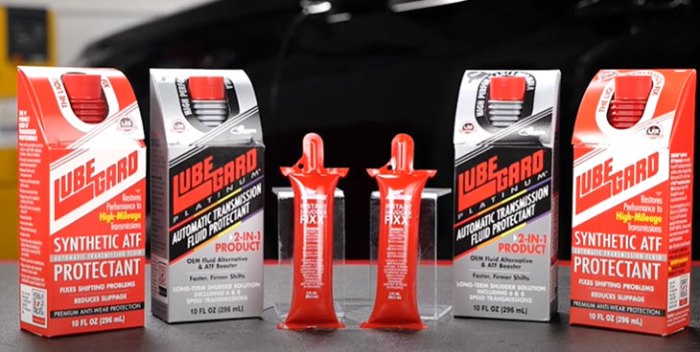How to fix transmission shudder in Chevy trucks? That’s a question a lot of truck owners grapple with. That annoying shuddering feeling – it’s not just annoying, it can be a sign of serious transmission trouble. This guide will walk you through identifying the cause, diagnosing the problem, and getting your Chevy back on the road smoothly.
We’ll cover everything from simple fluid checks to more involved repairs, so you can tackle this issue with confidence, whether you’re a seasoned mechanic or a DIY novice.
We’ll break down the process step-by-step, covering common symptoms, troubleshooting techniques, and repair options. Think of it as your ultimate guide to conquering that Chevy transmission shudder. We’ll even throw in some preventative maintenance tips to keep your truck running smoothly for years to come. So grab your wrench (metaphorically or literally!), and let’s get started.
Identifying the Shudder
Transmission shudder in a Chevy truck is a frustrating issue, often manifesting as a vibration or shaking felt throughout the vehicle, particularly during acceleration or deceleration. Understanding the root cause is key to effective repair, and pinpointing the problem often involves carefully examining symptoms and performing a few simple checks. Ignoring the problem can lead to more extensive and costly damage down the road.A shudder can stem from various issues, ranging from low transmission fluid to more serious mechanical problems within the transmission itself.
Differentiating between these causes is crucial for diagnosing the problem accurately. Low transmission fluid, for example, will often present as a shudder that worsens as the vehicle warms up, while mechanical issues might exhibit a consistent shudder regardless of temperature or driving conditions. The severity and consistency of the shudder are also important clues.
Transmission Fluid Inspection
Visually inspecting your transmission fluid is a simple yet valuable first step in diagnosing a shudder. The color, smell, and level of the fluid can provide significant insights into the health of your transmission. A dirty, burnt-smelling, low fluid level strongly suggests a problem.
| Fluid Color | Fluid Smell | Fluid Level | Possible Cause |
|---|---|---|---|
| Bright Red (new) to Dark Red (used) | Slightly sweet, almost imperceptible odor | Within the specified range on the dipstick | Normal operation; however, a dark red color may indicate the fluid is due for a change. |
| Brown, Dark Brown, or Black | Burnt, acrid odor | Low | Fluid is severely degraded; likely due to overheating or a leak. This strongly suggests internal transmission damage. |
| Pinkish or milky | Normal or slightly burnt | Normal or Low | Possible coolant leak into the transmission; requires immediate attention to prevent further damage. |
| Metallic particles present | Normal or slightly burnt | Normal or Low | Internal transmission wear; requires professional diagnosis and likely repair. |
To inspect the fluid, locate the transmission dipstick (usually marked with a transmission symbol). Remove the dipstick, wipe it clean with a rag, reinsert it fully, and then remove it again to check the fluid level. Observe the color and smell of the fluid on the dipstick. Compare your findings to the table above. Remember, always consult your owner’s manual for the specific location of the dipstick and proper procedure for your Chevy truck model.
If you are uncomfortable performing this check, consult a qualified mechanic.
Diagnosing the Problem
Okay, so your Chevy truck’s transmission is shuddering – not cool. Before you start throwing parts at it, let’s systematically diagnose the issue. A methodical approach will save you time, money, and frustration. We’ll look at checking the transmission fluid, scanning for codes, and investigating potential culprits like a worn-out torque converter.Checking the transmission fluid is a simple yet crucial first step.
Low fluid levels or contaminated fluid can cause all sorts of transmission woes, including shuddering. This process will give us a good starting point for further investigation.
Transmission Fluid Level and Condition
First, locate your transmission dipstick (usually marked with a “Trans” or similar designation). Make sure your truck is level on a flat surface and the engine is running and at operating temperature. Remove the dipstick, wipe it clean, reinsert it fully, and remove it again to check the fluid level. The level should fall within the marked range on the dipstick.
Next, examine the fluid’s color and smell. Fresh transmission fluid should be reddish-pink and have a relatively clean smell. Dark brown or burnt-smelling fluid indicates contamination and likely needs to be replaced. If the level is low, you’ll need to add fluid; if the fluid is severely contaminated, a complete flush and fill might be necessary. Remember to always use the correct type of transmission fluid specified in your owner’s manual.
Using the wrong fluid can damage your transmission.
Checking for Transmission Codes
Using an OBD-II scanner is the next step. These scanners are relatively inexpensive and can be purchased at most auto parts stores. Plug the scanner into your truck’s OBD-II port (usually located under the dashboard), turn the ignition on, and follow the scanner’s instructions to retrieve diagnostic trouble codes (DTCs). These codes provide valuable insights into potential transmission problems.A list of common transmission codes associated with shuddering includes:
- P0730-P0735: These codes indicate problems with the gear ratios, often pointing towards issues with the transmission’s internal clutches or gearsets. For example, P0733 indicates a problem with third gear.
- P0740-P0743: These codes relate to the torque converter clutch. A malfunctioning torque converter clutch is a frequent cause of shuddering, especially during acceleration. P0741, for instance, points to a torque converter clutch solenoid malfunction.
- P0750-P0758: These codes often indicate problems with the shift solenoids, which control the shifting of gears. A faulty solenoid can cause erratic shifting and shuddering. A P0753 code, for example, usually indicates a problem with the shift solenoid for second gear.
- P0870-P0877: These codes relate to low or high transmission fluid pressure. Incorrect pressure can lead to slipping and shuddering. For instance, P0871 would indicate low transmission fluid pressure.
Potential Causes of Shuddering: Worn Components
Several worn components can cause transmission shudder. The torque converter, responsible for smoothing out the transition between engine speed and transmission speed, can wear out over time, causing shuddering, especially during acceleration or deceleration. The clutches, responsible for engaging and disengaging gears, can also wear down, leading to slipping and shuddering. Other internal components like the valve body, responsible for controlling fluid flow, can also malfunction and contribute to transmission shudder.
These problems often require professional diagnosis and repair due to the complexity of transmission systems. Ignoring these issues can lead to more extensive and costly damage.
So, your Chevy truck’s transmission is shuddering? That’s a total bummer. Before you dive into a major repair, check your fluid levels first. If that’s good, you might want to consider upgrading other parts of your truck, especially if it’s a diesel. Maybe check out this guide on Best exhaust systems for diesel trucks 2025 to see if a better exhaust could improve performance and potentially indirectly affect transmission issues.
Getting back to that shudder, though, a worn torque converter could also be the culprit – definitely worth looking into.
Repair Options

So, you’ve identified a transmission shudder in your Chevy truck – now what? Let’s dive into the various repair options available, ranging from simple fluid changes to more involved procedures like torque converter replacement or even a full transmission rebuild. Choosing the right approach depends on the severity of the problem and your budget.
Transmission Fluid and Filter Replacement
A transmission fluid and filter change is often the first step in addressing a transmission shudder. Fresh fluid can help flush out contaminants and improve the transmission’s overall performance. However, this is unlikely to fix severe issues. A simple fluid change is a relatively inexpensive and straightforward process, even for a DIYer. Here’s a step-by-step procedure:
- Warm up the transmission by driving the truck for 10-15 minutes. This ensures the fluid is thin enough to flow properly.
- Securely position the truck on level ground and engage the parking brake.
- Locate the transmission pan underneath the vehicle. This usually requires crawling under the truck; safety first!
- Place a drain pan beneath the transmission pan to collect the old fluid. Expect several quarts.
- Carefully remove the transmission pan bolts, allowing the old fluid to drain completely. This can be messy, so be prepared.
- Once drained, remove the old transmission filter. Note its orientation for correct reinstallation.
- Install the new transmission filter, ensuring it’s seated correctly.
- Clean the transmission pan thoroughly, removing any debris or sediment.
- Replace the transmission pan gasket and reinstall the pan, tightening the bolts to the manufacturer’s specified torque.
- Using a funnel, add the correct type and amount of transmission fluid, as specified in your owner’s manual. Don’t overfill!
- Check the transmission fluid level using the dipstick, adding more fluid if needed. This usually involves running the engine and checking the fluid level again.
Comparison of Transmission Repair Options
The cost, time commitment, and long-term effectiveness vary significantly depending on the chosen repair method. Here’s a comparison:
| Repair Option | Cost Estimate | Time Required | Long-Term Effectiveness |
|---|---|---|---|
| Fluid Change & Filter | $50 – $200 (DIY) or $100 – $300 (Professional) | 1-3 hours (DIY) or 1-2 hours (Professional) | Short-term; may alleviate minor shudder, unlikely to fix major issues. |
| Transmission Rebuild | $1500 – $4000 | Several days | Long-term; restores transmission to near-new condition. |
| Transmission Replacement | $2500 – $6000+ (depending on the transmission type and availability) | Several days | Long-term; provides a completely new transmission. |
| Torque Converter Replacement | $800 – $1500 | 1-2 days | Long-term if the torque converter was the source of the problem. |
Torque Converter Replacement
Replacing a worn-out torque converter is a more involved procedure that typically requires specialized tools and some mechanical expertise. This isn’t a job for the average weekend mechanic. A faulty torque converter can cause shuddering, especially during acceleration or deceleration.The process involves dropping the transmission, removing the old torque converter, installing the new one, and then reinstalling the transmission.
This requires a transmission jack, various sockets and wrenches, a torque wrench, and potentially a transmission cooler line disconnect tool. Improper installation can lead to further damage, so professional assistance is highly recommended unless you possess significant mechanical experience and the correct tools. Failure to properly torque bolts during reassembly could result in leaks or catastrophic failure.
Consider the potential risks before attempting this repair yourself.
Preventative Maintenance: How To Fix Transmission Shudder In Chevy Trucks

Keeping your Chevy truck’s transmission in top shape isn’t just about fixing problems; it’s about preventing them in the first place. Regular maintenance is key to extending the life of your transmission and avoiding costly repairs down the road. Proactive care will save you money and headaches in the long run. This section Artikels a preventative maintenance schedule and highlights the importance of proper fluid and driving habits.Preventative maintenance for your Chevy truck’s transmission involves a combination of scheduled fluid changes and mindful driving practices.
Following a regular maintenance schedule, using the correct transmission fluid, and adopting smart driving habits can significantly extend the lifespan of your transmission and reduce the likelihood of encountering issues like shuddering.
So, your Chevy truck’s transmission is shuddering? That’s a major bummer, but before you panic and start looking at pricey repairs, consider the root cause. If you’re thinking about replacing your truck altogether, check out this list of Cheapest trucks under $30k with good MPG 2025 to see if a newer, more fuel-efficient option might be a better long-term solution.
But if you’re committed to fixing your current truck, remember to check your fluid levels and filter first – that’s often the easiest fix for transmission shudder.
Transmission Fluid Change Schedule, How to fix transmission shudder in Chevy trucks
Regular transmission fluid changes are crucial for optimal performance and longevity. Old fluid breaks down, loses its lubricating properties, and can lead to increased friction and wear on internal components. The following table Artikels a recommended schedule, but always consult your owner’s manual for the most accurate recommendations for your specific Chevy truck model and year. These recommendations are general guidelines and may vary based on driving conditions and usage.
| Maintenance Task | Recommended Frequency |
|---|---|
| Transmission Fluid and Filter Change | Every 30,000-60,000 miles, or as recommended in your owner’s manual |
| Transmission Fluid Level Check | Every 3,000-5,000 miles |
Choosing the Correct Transmission Fluid
Using the incorrect transmission fluid can severely damage your transmission. Different Chevy truck models require specific types of transmission fluid, often designated by a GM part number or a specific DEXRON specification (e.g., DEXRON VI). Always refer to your owner’s manual to identify the correct fluid type for your specific vehicle. The owner’s manual will usually list the recommended fluid type by either the GM part number or a DEXRON specification.
Using the wrong fluid can lead to premature wear, reduced performance, and ultimately, transmission failure. For example, using a fluid with an incorrect viscosity can result in insufficient lubrication, leading to overheating and component damage. Never guess; always check your owner’s manual.
Impact of Driving Habits on Transmission Longevity
Your driving habits significantly impact your transmission’s lifespan. Aggressive driving practices, such as rapid acceleration, hard braking, and frequent shifting, put excessive stress on the transmission components, leading to premature wear and tear. Conversely, smooth driving practices can significantly extend the life of your transmission.Here are some examples of driving practices that minimize stress on the transmission:* Avoid harsh acceleration and braking: Accelerate and decelerate smoothly and gradually.
Don’t hold the brake while accelerating
This creates unnecessary stress on the transmission.
Avoid prolonged idling
Excessive idling can cause the transmission fluid to overheat.
Shift smoothly
Avoid jerky or abrupt shifting.
Don’t tow heavy loads without proper equipment
Overloading your truck can significantly strain the transmission.
Warm up the transmission before heavy use
Allow the transmission fluid to reach its optimal temperature before engaging in strenuous driving, especially in cold weather.
Illustrative Examples
Let’s look at some real-world examples of transmission shudder in Chevy trucks and how they were diagnosed and repaired. Understanding these cases will help you better troubleshoot your own shudder issues.
Low Transmission Fluid Case Study
A 2005 Chevy Silverado 1500 was brought in with a noticeable shudder during acceleration, particularly noticeable between 30-40 mph. The owner reported a gradual worsening of the shudder over several months. Inspection revealed low transmission fluid levels. The fluid that was present was also dark brown and smelled burnt, indicating significant degradation. The repair involved a complete fluid and filter change.
After topping off the fluid to the proper level, the shudder was completely eliminated. This highlights the importance of regular transmission fluid checks and changes. Neglecting this simple maintenance task can lead to significant transmission damage.
Failing Torque Converter Case Study
A 2010 Chevy Colorado experienced a harsh shudder during acceleration from a stop. The shudder was most pronounced when the truck was cold and lessened slightly as it warmed up. Diagnostic testing revealed slippage in the torque converter. Upon removal, the torque converter showed significant wear on the impeller vanes. These vanes were visibly bent and scarred, suggesting prolonged operation under stress.
The internal clutch plates also showed signs of wear. The repair consisted of replacing the entire torque converter assembly. After installation of the new torque converter, the shudder was resolved.
Internal Transmission Mechanical Problem Case Study
A 2015 Chevy Silverado 2500HD experienced a shudder that was intermittent and seemed to be related to specific gear changes, primarily between second and third gear. The shudder wasn’t always present and wasn’t consistently linked to acceleration or load. This pointed to a potential internal transmission problem. A more thorough diagnostic scan revealed a fault code indicating a problem with the 2-3 shift solenoid.
This solenoid is responsible for controlling the flow of fluid to engage the correct clutch packs for the shift. Repair involved replacing the faulty solenoid within the transmission. After the repair, the shudder was no longer present. The intermittent nature of the shudder, linked to a specific gear change, helped pinpoint the problem to a specific component within the transmission rather than a broader issue like low fluid or a failing torque converter.
Closure

Fixing transmission shudder in your Chevy truck can range from a simple fluid change to a more complex repair, but with a systematic approach and the right information, you can get it sorted. Remember, regular maintenance is key to preventing future issues, so stick to a preventative maintenance schedule and pay attention to those early warning signs. By understanding the common causes and taking proactive steps, you can keep your Chevy truck running smoothly and avoid costly repairs down the road.
Now get out there and enjoy the ride!









